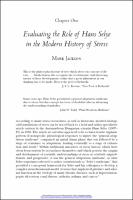Chapter 1 Evaluating the Role of Hans Selye in the Modern History of Stress
| dc.contributor.author | Kirk., Robert G.W. | |
| dc.contributor.author | Jackson, Mark | |
| dc.contributor.author | Ramsden, Edmund | |
| dc.contributor.author | Cantor, David | |
| dc.date.accessioned | 2014-05-28 00:00:00 | |
| dc.date.accessioned | 2020-04-01T12:40:26Z | |
| dc.date.available | 2020-04-01T12:40:26Z | |
| dc.date.issued | 2014 | |
| dc.identifier | 1000014 | |
| dc.identifier | OCN: 1076724020 | en_US |
| dc.identifier.uri | http://library.oapen.org/handle/20.500.12657/29940 | |
| dc.description.abstract | Stress is one of the most widely utilized medical concepts in modern society. Originally used to describe physiological responses to trauma, it is now applied in a variety of other fields and contexts, such as in the construction and expression of personal identity, social relations, building and engineering, and the various complexities of the competitive capitalist economy. In addition, scientists and medical experts use the concept to explore the relationship between an ever increasing number of environmental stressors and the evolution of an expanding range of mental and chronic organic diseases, such as hypertension, gastric ulcers, arthritis, allergies, and cancer. This edited volume brings together leading scholars to explore the emergence and development of the stress concept and its definitions as they have changed over time. It examines how stress and closely related concepts have been used to connect disciplines such as architecture, ecology, physiology, psychiatry, psychology, public health, urban planning, and a range of social sciences; its application in different settings such as the battlefield, workplace, clinic, hospital, and home; and the advancement of techniques of stress management in a number of different national, sociocultural, and scientific locations. | |
| dc.language | English | |
| dc.relation.ispartofseries | Rochester Studies in Medical History | |
| dc.subject.classification | thema EDItEUR::M Medicine and Nursing::MB Medicine: general issues::MBX History of medicine | en_US |
| dc.subject.other | history of science & medicine | |
| dc.subject.other | history of science & medicine | |
| dc.subject.other | Adrenal gland | |
| dc.subject.other | Corticosteroid | |
| dc.subject.other | Hans Selye | |
| dc.subject.other | Hormone | |
| dc.subject.other | Physiology | |
| dc.subject.other | Steroid | |
| dc.subject.other | Stress (biology) | |
| dc.title | Chapter 1 Evaluating the Role of Hans Selye in the Modern History of Stress | |
| dc.type | chapter | |
| oapen.identifier.doi | 10.26530/oapen_478052 | |
| oapen.relation.isPublishedBy | 2ec59728-955a-4262-a446-e1a2e1f2c8e1 | |
| oapen.relation.isPartOfBook | 77659c2d-18a5-47d5-8218-5d9b171d147a | |
| oapen.relation.isFundedBy | d859fbd3-d884-4090-a0ec-baf821c9abfd | |
| oapen.collection | Wellcome | |
| oapen.place.publication | Rochester | |
| oapen.chapternumber | 1 | |
| oapen.grant.number | 082834 (chapter 1) and 084988 (chapter 9) | |
| oapen.remark.public | Relevant Wikipedia pages: Adrenal gland - https://en.wikipedia.org/wiki/Adrenal_gland; Corticosteroid - https://en.wikipedia.org/wiki/Corticosteroid; Hans Selye - https://en.wikipedia.org/wiki/Hans_Selye; Hormone - https://en.wikipedia.org/wiki/Hormone; Physiology - https://en.wikipedia.org/wiki/Physiology; Steroid - https://en.wikipedia.org/wiki/Steroid; Stress (biology) - https://en.wikipedia.org/wiki/Stress_(biology) | |
| oapen.identifier.ocn | 1076724020 |

